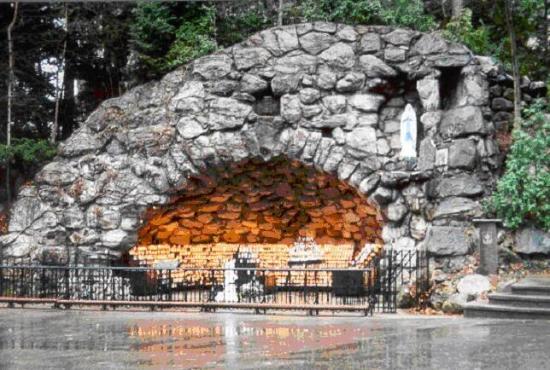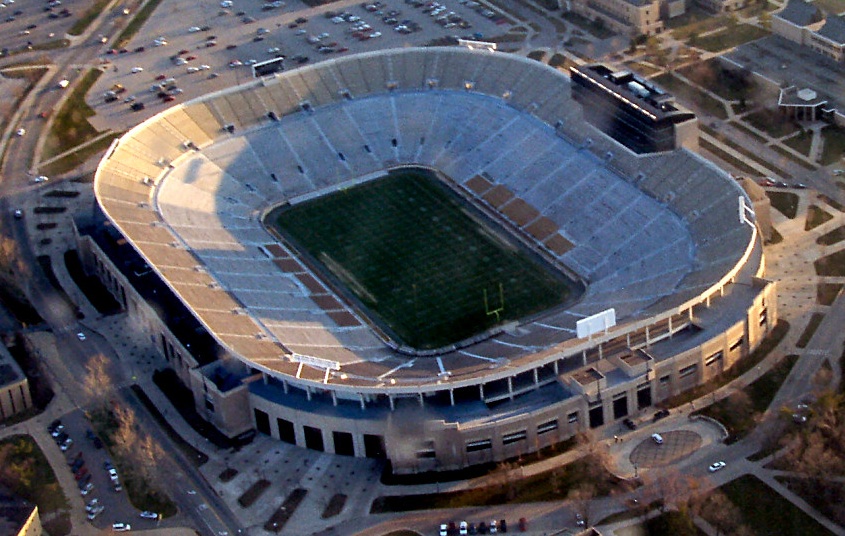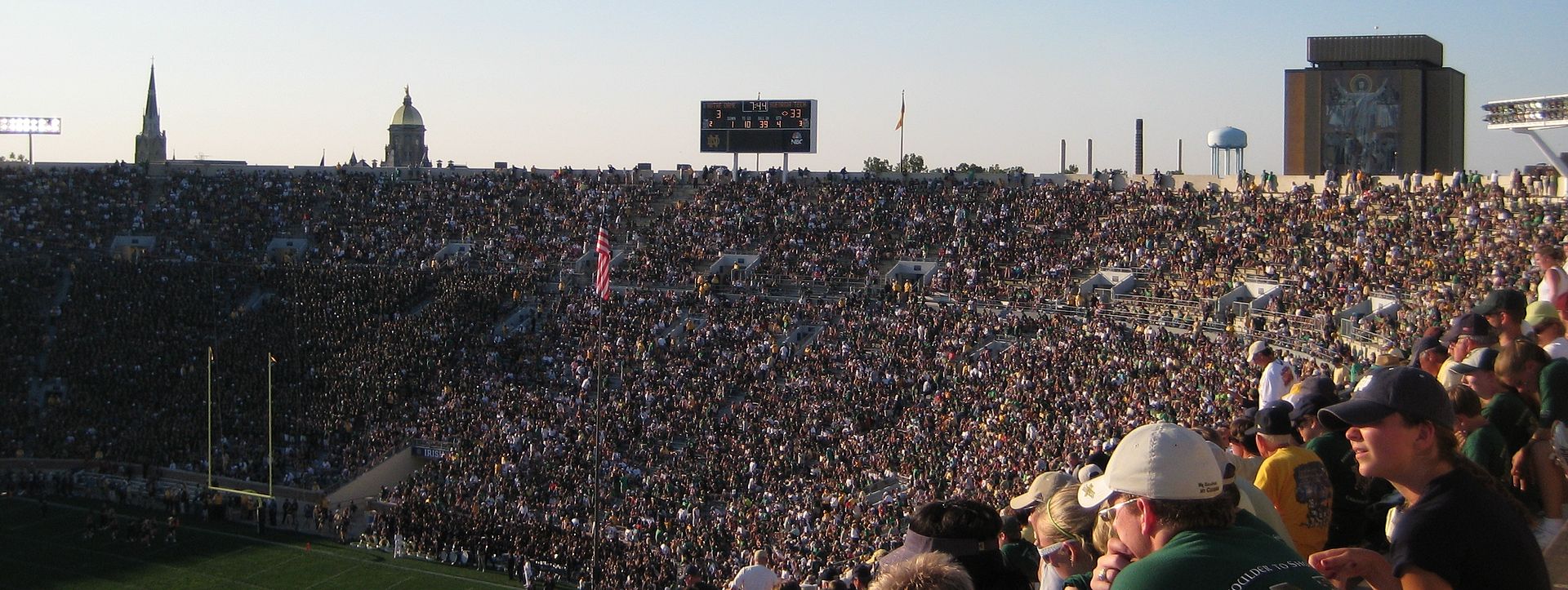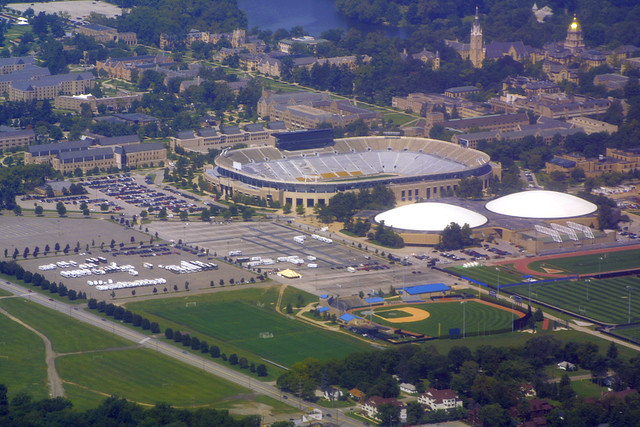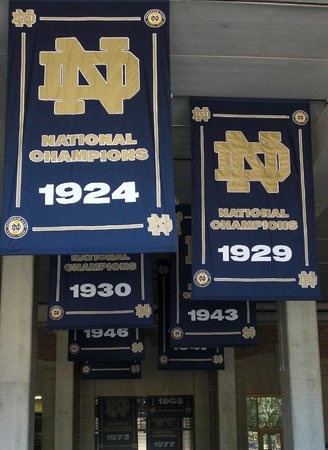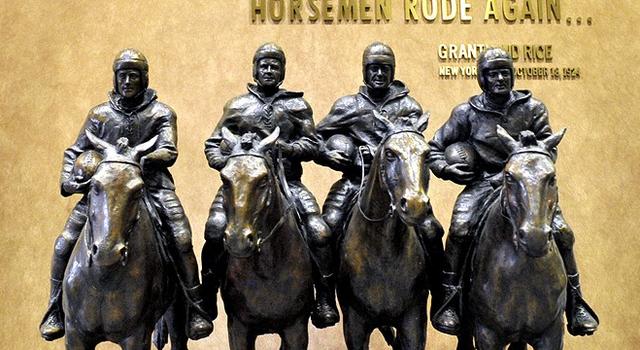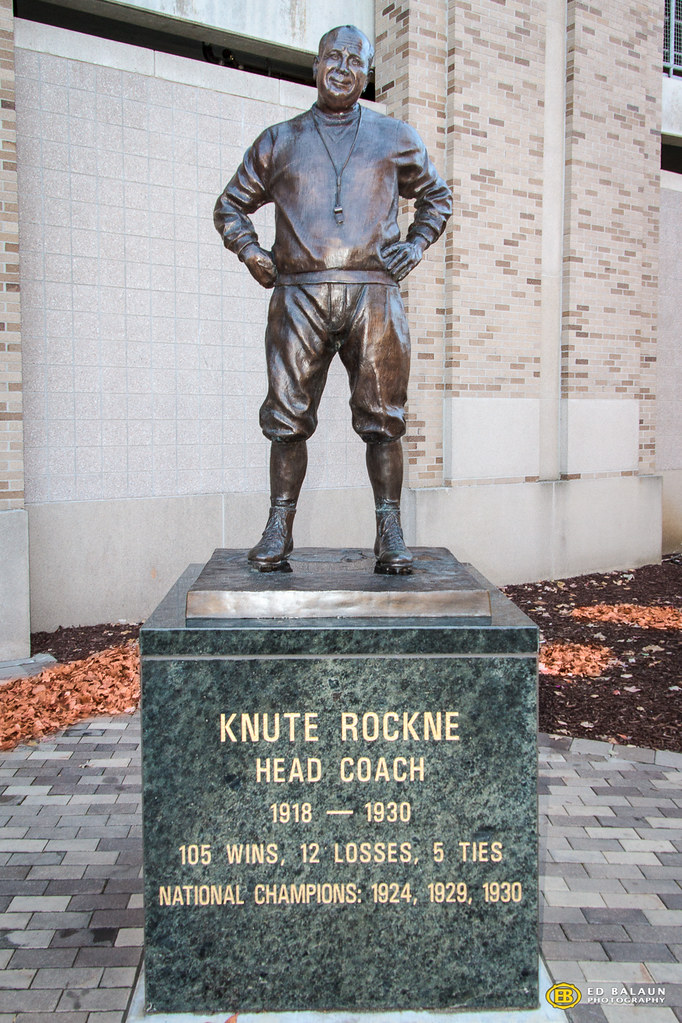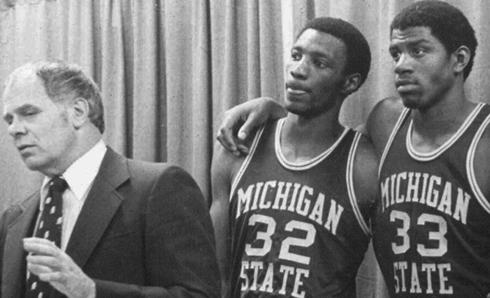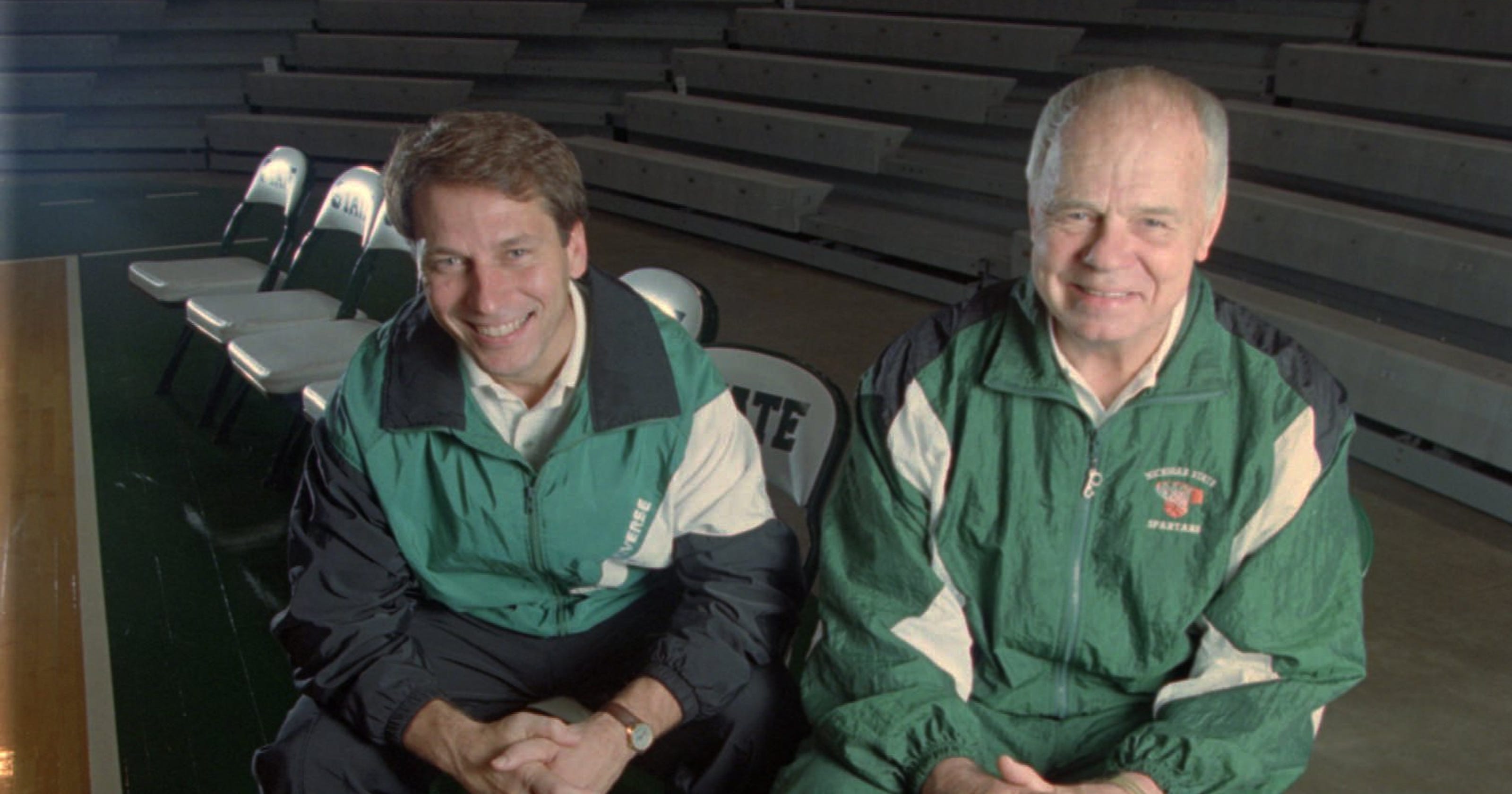"There are Notre Dame fans, and there are Notre Dame haters. And, frankly, they're both a pain in the ass." -- Dan Devine, Notre Dame head coach, 1975-80
And there are plenty of both. For better or for worse, even more so than The Catholic University of America, located in Washington, D.C., the University of Notre Dame (Latin for "Our Lady") is the Catholic university of America. And a lot of people of other religions admire it, too.
Academically and athletically, there is reason for this. On the other hand, I've seen lists of the Top 10 (including
my own), 20 (
Bleacher Report), 31 (
Buzzfeed), 111 (a University of Michigan fan's blog), and even 303 (radio show host and University of Alabama fan Paul Finebaum's book) Reasons to Hate Notre Dame.
This Sunday, they open their season at home, facing Philadelphia's Temple University.
Before You Go. As a Midwestern city, with 45 miles of a Great Lake (Lake Michigan), South Bend can get pretty cold in the Autumn and winter. That shouldn't be a problem if you go early enough in the season. This weekend, for example, the weather is forecast as being in the mid-70s in the afternoon, and the high 50s at night. If this is your weekend to go, you shouldn't need a jacket. But for October and November, you should wear one.
The time zone situation in Indiana has long been screwy, but South Bend is in the Eastern Time Zone, so you won't have to fiddle with your timepieces.
Tickets. Good luck. Notre Dame has had 6 home games every season of this decade, except for 2010 when they had 7, and all of these games had a listed attendance of 80,795.
Ticketmaster has a few resale tickets available for $70 to $75, but most of what's available from them and other such outlets goes for twice that, or more.
I wonder what the Catholic teaching on ticket scalping is.
Getting There. It's 705 miles from Times Square in Midtown Manhattan to Notre Dame Stadium in South Bend, Indiana. Your first reaction will be to fly. There is a South Bend International Airport, but it's very hard to get a round-trip nonstop flight there from New York, and harder still to get one for under $1,000. Perhaps you could fly to Chicago, rent a car at O'Hare, and drive the last 111 miles.
Amtrak's
Lake Shore Limited leaves Penn Station in New York every day at 3:40 PM, and arrives at South Bend at 8:49 AM. It leaves South Bend just before midnight at 11:59 PM, and returns to New York the next evening at 6:23 PM. Round-trip fare is $210. The Amtrak station is at 2702 W. Washington Street. But you'd have to walk half a mile south on Meade Street to get to Western Avenue, then take Bus 10 to South Street, and switch to Bus 7 to the campus. Between them, the buses should take about 20 minutes.
Greyhound has 3 departures every day from Port Authority Bus Terminal, and round-trip fare is $418, but it can drop to $388 with advanced purchase. The Greyhound station is at 4671 Progress Drive, at the airport, but even though it's further away from the campus than the train station, getting there is easier: The Airport SuperSaver bus can get you to the campus in half an hour.
If your choice is to drive, the directions are rather easy. Take Interstate 80 West until it merges with Interstate 90. Once it becomes the Indiana Toll Road, take Exit 77 to Douglas Road, and turn right on Business U.S. Route 31, Michigan Street. Soon, the campus will be on your left.
If you do it right, you should spend about an hour and 15 minutes in New Jersey, 5 hours and 15 minutes in Pennsylvania, 4 hours in Ohio and 2 hours in Indiana. That's 12 and a half hours. With rest stops, preferably 1 in Pennsylvania, 1 in Ohio, and another near the State Line of both, that's about 15 hours.
Once In the City. Located in St. Joseph County, on the St. Joseph River, in north central Indiana, South Bend is home to a little over 100,000 people, but would be a wholly unremarkable place if not for the University of Notre Dame. Founded in 1865, it is the 4th largest city in the state and the economic hub of northern Indiana.
Street addresses are divided into East and West by Michigan Street, which is also known as Martin Luther King Jr. Blvd. (and also, essentially, the River), and into North and South by Washington Street.
The sales tax in the State of Indiana is 7 percent. ZIP Codes in South Bend start with the digits 465, and the Area Code is 574. The leading newspaper is the
South Bend Tribune. The South Bend Public Transportation Corporation, or "South Bend Transpo," runs buses with a base fare of just $1.00. The city has no freeway "beltway." South Bend is about 59 percent white, 27 percent black, 13 percent Hispanic and 1 percent Asian. Indiana Michigan Power runs the electricity.
Once On the Campus. Although a County Seat, the city is dominated by the University of Notre Dame, founded in 1842. The school's most familiar feature is the Main Administration, a.k.a. the Main Building or the Golden Dome. As a result, Notre Dame students are often called Domers. The 1st one was built in 1844, burned down in 1879, and was then replaced by the current structure. They also have a reproduction of the Grotto of Our Lady of Lourdes, in Lourdes, France, to dovetail with the school's name. (Again: "Notre Dame" is French for "Our Lady.")
The Grotto
Aside from that Dome, the Grotto and the Stadium, the most familiar structure on the campus is the Theodore M. Hesburgh Library. Opened in 1963 as simply the Memorial Library, it was renamed for Father Hesburgh, who served as the University's President from 1952 to 1987, and got it built.
The Library towers over the north end of the Stadium, separated from it by a reflecting pool, and is dominated by a 134-foot-high mural officially named
The Word of Life. Since the building was a library, Hesburgh wanted a mural that would depict Christian thinkers and scholars throughout history. He got it, from painter Millard Sheets, who put Christ, who was called "Rabbi" ("Teacher") by his followers in his time, top and center, with his arms outstretched.
But since the mural is easily visible from the stadium, and Jesus' arms are raised, the figure is known as known as "Touchdown Jesus." Certainly, Hesburgh wanted to win football games, but this was far from his vision for the library he built. To make matters worse, the Stadium's 1996 expansion obscures the lower half of the mural, so that most of the "scholars" and "thinkers" aren't visible, and only Jesus' "touchdown signal" can be seen.
True,
The Apostle's Creed states of Jesus, "He shall come to judge the quick and the dead," but no dogma of any religion says anything about its messiah officiating at sporting events.
Long preferring to stay independent in sports, Notre Dame is now a member of the Atlantic Coast Conference in all sports, except hockey, where it is a member of the Big Ten; and football, where it remains an independent. The reason they chose to remain independent in football, despite playing some of the Big Ten schools every year (Michigan, Michigan State, Purdue, and frequently Northwestern), is that they did not want to split the bowl money they got with their conference opponents.
That was the official story. Some people have suggested that they did not want to play Michigan and Ohio State every year; and then, once Penn State and then Nebraska came into the Big Ten, making it 4 major powers, perhaps the Fighting Irish lost some of their fight, and were, indeed cowards.
As for that nickname: Like Loyola University of Chicago, Notre Dame originally called its teams the Ramblers. It wasn't until ND alumnus Francis Wallace began using the phrase "Fighting Irish" in his New York Daily News columns in the 1920s that anybody thought to call them that. In 1927, the University President, the Rev. Matthew Walsh, made it official. (At least Walsh was Irish.)
How accurate is the "Irish" nickname? Well, Frank Leahy, coach of their 5 National Championship teams of the 1940s, was Irish. So was Ned Joyce, the administrator for whom their indoor sports arena is named. So were two of the members of the legendary mid-1920s backfield, the Four Horsemen: Jim Crowley and Elmer Layden. So were George Gipp, Johnny "Blood" McNally, Leon Hart, George Connor, Johnny Lattner, Terry Hanratty, Mike McCoy, Tom Clements, Dan Devine, Ken McAfee, Dave Casper, Brady Quinn, and current head coach Brian Kelly.
But, ahem. Knute Rockne, who helped establish the team (more about that in "Team History Displays"), was Norwegian. Moose Krause, the basketball coach whose name graces the road surrounding the athletic complex? Lithuanian. Father Hesburgh? German.
The other two Horsemen? Don Miller was English, and Harry Stuhldreher was German. Wayne Millner, Paul Hornung, Joe Theismann, Lou Holtz, and Daniel Ruettiger Jr., a.k.a. "Rudy"? All German. Angelo Bertelli, Ralph Guglielmi, Nick Buoniconti and Joe Montana? Italian. Johnny Lujack, Emil Sitko, Bill Wolski, Walt Patulski? Polish. Chris Zorich? Half-black, half-Croatian. John Huarte? An anglicization of the French name Huard. Curly Lambeau? Also French. Ara Parseghian, who just died a few weeks ago? Until Kim Kardashian came along, he was easily the most famous American of Armenian descent.
And that's before you factor in black stars like Zorich, Alan Page, Ross Browner, Vagas Ferguson, Allen Pinkett, Tim Brown, Tony Rice, Raghib "Rocket" Ismail, Ricky Watters, and Jerome Bettis, and the Samoan Manti Te'o.
An old joke: What do you call five Italians, three Poles and three black guys? "The Fighting Irish." Another old joke is that if it wasn't for Italian and Polish guys from Chicago and environs, there wouldn't be much fight in the Fighting Irish.
Yet if someone is Irish, and especially Irish Catholic, rooting against Notre Dame is "against your religion." Oy vey. Well, if Boston College football, and Georgetown and Villanova basketball, are any indication, there's a lot of Catholics who haven't drunk the South Bend Kool-Aid. Some of them have even got to be Irish (particularly at BC).
Notable Notre Dame athletes in sports other than football:
* Baseball: Red Murray Class of 1906, Cy Williams 1912, Ron Reed '65 (also played in the NBA), Craig Counsell '92, Aaron Heilman '01, John Axford '05. Cap Anson, Louis Sockalexis, Carl Yastrzemski, Jeff Samardzija and Brad Lidge also attended Notre Dame, but did not graduate.
* Basketball: Ray Meyer '38 (later the longtime DePaul University head coach) Gary Brokaw '74 (from New Brunswick, New Jersey), Adrian Dantley '76, Bill Laimbeer '79, Kelly Tripucka '81 (from Bloomfield, New Jersey, son of pro quarterback Frank Tripucka), Orlando Woolridge '81, John Paxson '83, LaPhonso Ellis '92, Pat Garrity '98, Luke Harangody '10, Ben Hansbrough '11. Austin Carr also played at Notre Dame, but did not graduate.
* Hockey: Bill Nyrop '74 (played on Montreal Canadiens' 4 straight Stanley Cup winners 1976-79).
* Soccer: Joseph Lapira '08, Matt Besler '08, Kerri Hanks '09.
* Olympic Gold Medalists: Vince Boryla, basketball, 1948; Shannon Boxx and Kate Markgraf, women's soccer, 2004; Mariel Zaguins, women's fencing, 2004 and 2008.
* Sportscasters: Don Criqui '62, Hannah Storm '83.
* Sportswriters: Red Smith '27.
Notable Notre Dame graduates in other fields include:
* Business: Edward J. DeBartolo Sr. '31 and Jr. '68, shopping mall developers and sports team owners, Sr. owning the Pittsburgh Penguins, Jr. the San Francisco 49ers, and brother-in-law of current 49ers owner and ND grad John York '71; Jim Fitzgerald, owned the NBA's Milwaukee Bucks and later the Golden State Warriors; Larry Dolan '56, cable-TV pioneer and owner of the Cleveland Indians; Vince Naimoli '59, owner of the Tampa Bay Rays; Joe Garagiola Jr. '72, lawyer, baseball team executive, and son of the catcher-turned-broadcaster.
* Entertainment: Regis Philbin '53, talk- and game-show host; Don Ohlmeyer '67, longtime NBC executive and TV producer; Richard Riehle '70, one of those "Oh yeah, uh... him!" actors you recognize but can never remember his name; and the entire membership of the band Umphrey's McGee, composers and performers of the theme song for ESPN's Around the Horn; all ND Class of '98: Brendan Bayliss, Joel Cummins, Mike Mirro and Ryan Stasik. George Wendt of Cheers attended Notre Dame, but did not graduate.
* Journalism: Phil Donahue '57, Mark Shields '59, Terence Smith '60, Anne Thompson '79.
* Literature: Edwin O'Connor '93, Nicholas Sparks '88.
* Religion: John Francis O'Hara, President of Notre Dame from 1934 to 1945, and Archbishop of Philadelphia from 1951 until his death in 1960; and William Donald Borders '47, Archbishop of Baltimore. Interestingly, both Cardinals were Archbishops when their cities' most successful teams to that point left town: O'Hara with the Athletics in 1954, and Borders with the Colts in 1984.
Political figures who graduated from Notre Dame:
* Senators: Edward Carville 1909 of Nevada, Joe Donnelly '77 of Indiana, and Jeffrey Chiesa '87 of New Jersey (briefly in 2013, between the death of Frank Lautenberg and the election of Cory Booker),
* Congressmen: William E. Miller '35, Representative from New York (Western), and Republican nominee for Vice President in 1964; Peter King '68, Representative from New York (Long Island) and hater of terrorism unless it's Irish.
* Governors: Carville; Harry Kelly 1917 of Michigan, John McKiernan '34 of Rhode Island, John Gilligan '43 of Ohio, Thomas Judge '57 of Montana, Bruce Babbitt '60 of Arizona (ran for President in 1988), Joe Kernan '68 of Indiana, and Bob McDonell '76 of Virginia.
* Cabinet members: Richard V. Allen '82 was National Security Adviser under President Ronald Reagan; the aforementioned Bruce Babbitt was Secretary of the Interior under President Bill Clinton; Condoleeza Rice '75 was National Security Adviser under President George W. Bush.
* Big-city Mayors: Peter Flaherty '51 of Pittsburgh.
No President of the United States has attended Notre Dame, although Josiah "Jed" Bartlet, the fictional President from the TV show The West Wing, was ND Class of '64; and Reagan famously played George Gipp before going into politics. Jose Napoleon Duarte '48 was President of El Salvador, guilty of terrible war crimes during their 1980s civil war, and supported by the Reagan Administration. Ernesto Perez Balladares '67 was elected President of Panama.
Going In. Notre Dame Stadium, "The House That Rockne Built," opened in 1930 -- which, as it turned out, was Knute Rockne's last year as head coach. He died in a plane crash in 1931, in Kansas to visit his sons at a boarding school there. He was only 43 years old, but the footage we have of him, all black and white, makes him look much older.
Notre Dame Stadium will never have a corporate sponsor on its name, because the name "Notre Dame" is, itself, able to generate enough revenue, a brand name every bit as much as the name "Yankee Stadium."
From the beginning, the seating capacity of Notre Dame was 59,075. A renovation in 1996 expanded it to 80,795, a new one just completed raised it to about 84,000 (they haven't released an official tabulation yet), and the demand for tickets still far exceeds supply. As you can see in this photo, from the south end, with the Hesburgh Library and Touchdown Jesus behind the north end, the visiting school's students and band, in this case those of the University of Michigan, are put in the northwest corner.

The stadium itself is not an architectural marvel. Indeed, the greatest thing about it is usually the team. There are no great columns like at Ohio Stadium, or Memorial Stadium in Illinois, or at Soldier Field in Chicago. Like Michigan Stadium, it's pretty much just a big stadium with an incredibly successful team in it. The field runs north to south, and was always natural grass until 2014, when it was replaced with FieldTurf. It didn't host a night game until temporary lights were brought in for a 1982 game, and it didn't get permanent lights until the 1996-97 expansion.
The north end, with the Golden Dome
and the Hesburgh Library behind it.
Photo taken September 1, 2007.
Georgia Tech beat them 33-3.
UPDATE: On October 6, 2017,
Thrillist compiled a list of their
Best
College Football Stadiums, the top 19 percent of
college football, 25 out of 129. Notre Dame Stadium was ranked 7th:
Sure, the Fighting Irish haven’t won a title in over 25 years, but ask any college football fan for their stadium bucket list, and South Bend comes up every time. Can’t make it there for a game? Ryan McGee says you’re still in luck. “Game days are great,” he says, “but the $10 off-season tour might be even better.”
The official address of the stadium is Moose Krause Circle, about 2 miles northeast of downtown South Bend. Bus 7 will get you from downtown to the Hesburgh Library, and from there it's a short walk to the Stadium. If you drive in, parking is $30.
Edward Walter Kriaučiūnas, alias Ed "Moose" Krause, played football and basketball at Notre Dame in the early 1930s, and was the basketball coach and an assistant football coach in the 1940s. Moose Krause Circle surrounds not only the Stadium, but, to the east of it, the Edmund P. Joyce Convocation Center, with its 2 white domes, including the basketball arena, a hockey rink and an aquatic center.
Notre Dame Stadium and the Joyce Center
The arena, built in 1968 as The Athletic & Convocation Center, was renamed in 1987, as a tribute to Joyce, long a vice president of the University. As Hesburgh said: "Father Ned Joyce was my right-hand man for the entire 35 years that I was president of Notre Dame. It would be impossible to recount, even in cursory fashion, all the great things he did for Notre Dame during his 35 years as executive vice president. Without him, both the University and I would have been much diminished.
The Joyce Center is a house of upsets: UCLA's record 88-game winning streak was bookended by losses there in 1971 and 1974. (Never,
ever mention that 1974 game to Bill Walton, in the event you should meet him.) In addition to those wins, Notre Dame also upset the basketball team then ranked Number 1 in the nation in 1977 (San Francisco), 1980 (DePaul), 1987 (North Carolina), 1991 (UCLA again), 2012 (Syracuse), and 2016 (North Carolina again).
Elvis Presley sang at the Joyce Center, under its original name, on September 30 and October 1, 1974, and again on October 20, 1976. The Beatles did not play in South Bend on any of their North American tours.
Previously, they played at the Notre Dame Fieldhouse, which stood from 1900 to 1968 in what's now Fieldhouse Mall, to the west of Hesburgh Library. The basketball team was retroactively awarded National Championships for the 1927 and 1936 seasons, but they've only made the NCAA Final Four once, in 1978. The women's team, under head coach Ann "Muffet" McGraw, who just got elected to the Basketball Hall of Fame, has been far more successful, winning the National Championship in 2001.
To the east of the Joyce Center is practice fields and the soccer and track facilities. This was the site of Cartier Field, where Notre Dame played football prior to the opening of the current stadium, and George Gipp and the Four Horsemen did their stuff. To the south of the Stadium and the Joyce Center are Compton Family Ice Arena, built in 2011 as the new home of the hockey team; and Frank Eck Baseball Stadium. (UPDATE: Compton Arena has held the Final of the Big Ten Hockey Tournament since 2018.)
Notre Dame Stadium will host the NHL Winter Classic on New Year's Day, January 1, 2019, between a pair of "Original Six" teams from a pair of notably Irish cities: The Chicago Blackhawks, the "hosts"; and the Boston Bruins. (UPDATE: The Bruins won, 4-2.)
Food. This is the Midwest, Big Ten Country (though Notre Dame is not in the Big 10 for any sport except hockey), where food at sporting events is essential, and tailgating is -- although I hesitate to use this word when the subject is Notre Dame -- a sacrament. But Notre Dame Stadium is one college football ground where you may have better options than tailgating, or pubgoing before and/or after the game.
Being a college stadium, beer and other alcoholic beverages are not sold. There are what they call "Traditional Concession Fare" stands all over the Stadium, with hot dogs, bratwurst, nachos, jumbo pretzels, popcorn, candy, soft drinks, coffee and hot chocolate. But there are also specialty stands.
Under Section 7 in the lower level and 101 in the upper deck, is Domer Deli, with premium hand-carved sandwiches, turkey and prime rib, served with homemade chips. Under Sections 13 and 31 in the lower level is Gold Grill, with cheeseburgers, grilled chicken sandwiches, chicken tenders and fries. Under Sections 4, 9, 23 27 and 31 in the lower level are stands serving pot roast sandwiches. Under Section 12 is BBQ Nachos. Under Section 18 is a pizza-by-the-slice stand. Under Section 30 is Prime Rib Nachos. And Section 31 is the Specialty Sausage Stand.
Team History Displays. Perhaps even more than the Yankees and the Montreal Canadiens, Notre Dame football likes to remind you of its history. They'd probably like you to think of them as "the Yankees of College Football," especially given how many games they've played at Yankee Stadium. They beat Army at the new one in 2010, after playing 24 games at the old one, going 15-6-3.
Most notable were the 1928 and 1946 games against Army. In 1928, they trailed 6-0 at halftime, and Rockne told the team about George Gipp, who helped them win the 1920 National Championship, but soon died. In those pre-antibiotic days, you really could die from something as simple as strep throat.
As Rockne told it, Gipp told him on his deathbed, "Sometime, when the team is up against it, and the breaks are beating the boys, tell them to go out there with all they've got, and and win just one for the Gipper. I don't know where I'll be then, Rock, but I'll know, and I'll be happy." And then he told them, "Gentlemen, this is that game." And the players left the locker room in tears, and came from behind, and beat Army 12-6.
The truth? George Gipp was an alcoholic. He was a womanizer. He attended classes about as often as the Pope lit a menorah. He hardly ever showed up for Mass, too. And he was a compulsive gambler, who bet on anything, including his own team. If he said anything to Rockne as he was dying on December 14, 1920, it was probably more along the lines of, "Put a hundred bucks on the 4 horse in tomorrow's 7th race at Arlington for me."
In spite of all that, because he was the best football player Notre Dame had yet seen, Knute Rockne got the administration to keep him on the team. But this was the dawn of mass media. The movie about Rockne and Gipp hadn't been made yet. These players would have been about 10 years old when Gipp played. So, presuming Rockne did give the speech -- regardless of whether he made it up or it was true -- it wouldn't have had much of an effect. But it makes a great story!
The 1946 game was billed as "The Game of the Century," because Notre Dame went into it ranked Number 2, Army was Number 1, and Army hadn't lost since Notre Dame beat them in 1943, and Notre Dame was undefeated as well, and they had won the last 3 National Championships between them, and whoever won this one would make it 4. It was broadcast coast-to-coast on radio. Network TV was still a year away, but it would have been huge on that, too. But the game didn't live up to the hype, and ended 0-0. Notre Dame got the National Championship anyway, just as they did 20 years later after their famous tie with Michigan State.
Notre Dame doesn't retire uniform numbers. They've won 7 Heisman Trophies: Quarterback Angelo Bertelli in 1943, quarterback Johnny Lujack in 1947, end Leon Hart in 1949, running back Johnny Lattner in 1953, quarterback Paul Hornung in 1956, quarterback John Huarte in 1964, and receiver Tim Brown in 1987. Bertelli and Lattner would see their pro careers cut short by military service. Lujack (now the oldest and earliest living Heisman winner) and Hart would have decent pro careers. Huarte turned out to be a bust. Hornung, moved to running back, and Brown are in the Pro Football Hall of Fame.
Other Pro Football Hall of Fame members to have played at Notre Dame are: 1920s Chicago Bears center George Trafton, 1930s Green Bay Packers running back Johnny "Blood" McNally, 1940s Washington Redskins end Wayne Millner, 1950s Bears linebacker George Connor, 1970s Minnesota Vikings defensive end Alan Page, 1970s Miami Dolphins linebacker Nick Buoniconti, 1970s Oakland Raiders tight end Dave Casper, 1980s San Francisco 49ers quarterback Joe Montana, 1990s Pittsburgh Steelers running back Jerome Bettis, and, although they weren't elected as players, longtime Packer coach Curly Lambeau and 49ers owner Eddie DeBartolo.
If you must know: At Notre Dame, Rockne, Lambeau and Gipp played before uniform numbers were worn; Montana wore 3; Layden, Hornung, Hanratty and Te'o, 5; Bettis, 6; Huarte and Theismann, 7; Rice, 9; Watters, 12; Lattner, 14; Miller, 16; Crowley, 18; Pinkett, 20; McNally, 24; Ismail, 25; Stuhldreher, Lujack and Ferguson, 32; Millner, 40; Ruettiger, 45; Bertelli, 48; Zorich, 50; Buoniconti, 64; Connor, Page and Brown, 81; Hart, 82; Casper, 87; and Browner, 89.
If they were to retire numbers, then, to keep it from getting out of control, like with the Yankees, the Canadiens, and that other title-laden team with a leprechaun mascot, the Boston Celtics, the best guideline would be to only do it for players who won both the Heisman Trophy and the National Championship. Therefore: 14 for Lattner, 48 for Bertelli, and 82 for Hart -- and that's it. Not 3 for Montana, 5 for Hornung, or 5, 16, 18 or 32 for the Horsemen.
Notre Dame has been awarded 12 National Championships: 1920, 1924, 1929, 1930, 1943, 1946, 1947, 1949, 1966, 1973, 1977 and 1988. By a weird string of events, Rockne (1920), Leahy (1943), Parseghian (1966), Devine (1977) and Holtz (1988) each won it in his 3rd season as head coach. (Don't get any ideas: Current coach Brian Kelly is starting his 8th season in South Bend.)
But the most important part of Notre Dame's football history isn't their National Championships. It's a game that was played on November 1, 1913, and if there is surviving film of it, it has never been released to the public.
Notre Dame, then just another of what we would now call the "mid-majors" among Catholic universities in the Midwest -- also including Xavier University in Cincinnati, the University of Detroit Mercy, DePaul and Loyola in Chicago, Marquette in Milwaukee and Saint Louis University -- did what Jim Thorpe, coach Pop Warner, and the Carlisle Indian School of Pennsylvania had famously done the season before: Upset Army. And they did it at West Point, no less.
They did it with the forward pass, which had been legalized 7 years earlier, but hardly used. Under head coach Jesse Harper, who would be replaced by Rockne in 1918, quarterback Charles "Gus" Dorias threw 17 passes to Rockne, completing 14, for 243 yards and 3 touchdowns. Notre Dame won, 35-13. Army wouldn't at West Point again for another 2 years. This made the forward pass worth noticing and trying, and it made Notre Dame a household name, before Rockne, as head coach, began cultivating the press and making it legend.
(Rockne and Dorais would briefly play in the pros, for the Massillon Tigers in Ohio, before the founding of the NFL. Dorais became the longtime head coach at Detroit Mercy. The Four Horsemen had brief pro careers as well, the NFL not really being a viable option in those days. Not until the 1950s did Notre Dame players begin to have great pro careers.)
Statue of the Four Horsemen inside the stadium.
Left to right: Jim Crowley, Elmer Layden,
Don Miller and Harry Stuhldreher.
Outside the stadium, there are statues of Rockne, Leahy, Parseghian, Devine and Holtz. Holtz is still alive, while Parseghian and Devine lived long enough to see their statues dedicated. There's also an equestrian statue inside the stadium, recreating the famous photo of the Four Horsemen.
With the Four Horsemen plowing through Stanford, Notre Dame won the 1925 Rose Bowl. Then they didn't accept another bowl berth until the 1969 season, which may have hurt them in National Championship consideration, especially since they didn't have a Conference whose Championship they could win.
They've now been to 34, winning 16, including the aforementioned 1925 Rose Bowl; the 1971, 1978, 1979, 1993 and 1994 Cotton Bowls; the 1974 and 1992 Sugar Bowls; the 1975 and 1990 Orange Bowls; and the 1989 Fiesta Bowl. Notre Dame was the 1st of 6 schools to have won all 5 major
bowls, achieving it in 1989. The others: Penn State in 1994, Ohio State in 1998, Miami in 2001, Texas in 2004 and
Oklahoma in 2010.
Notre Dame has a few rivalries. They play both Army and Navy regularly. They lead Army 39-8-4, and haven't lost to them since 1958, having beaten them 15 straight times since 1965, including 2010 at Yankee Stadium and last year at the Alamodome in San Antonio. It was played locally on the West Point campus from 1913 to 1922, and again in 1973; at the old Yankee Stadium 1925-29, 1931-46, and 1969; at Ebbets Field in 1923, at the Polo Grounds in 1924, at Shea Stadium in 1965, and at Giants Stadium in 1977, 1983 and 1995. It's also been played at JFK Stadium in Philadelphia (then Municipal Stadium) and the old Soldier Field in Chicago.
The Navy rivalry is even more lopsided. It has been played every season since 1927, and Notre Dame leads 74-13-1, including winning every year from 1964 to 2006, 43 straight, an NCAA rivalry record. Navy has won 4 of the last 10, however. (UPDATE: Notre Dame now leads 76-13-1.)
This game was usually played at Baltimore's Municipal Stadium, and at its replacement, Memorial Stadium, in 1954, 1956, 1958, 1986 and 1988; and at the Ravens' M&T Bank Stadium in 2002, 2006 and 2008. The game was played at Soldier Field in 1928; Cleveland Municipal Stadium 11 times between 1932 and 1978; Giants Stadium in 1980, 1982, 1984, 1990, 1992 and 2004, and MetLife Stadium in 2010; in Philadelphia 8 times at JFK Stadium and in 1993 at Veterans Stadium; the Redskins' FedEx Field in 1998 and 2014; Orlando in 2000 and Jacksonville last year; and 1996 and 2012 in Ireland. (I'll get to that in a moment.)
Notre Dame has rivalries with some of the Big Ten schools. Although they've only rarely played Ohio State and Penn State, they have a 48-28-1 lead over Michigan State, and a 58-26-2 lead over Purdue, but trail Michigan 24-17-1. (UPDATE: Now 25-18-1.) The rivalry win the University of Miami has cooled off since the "Catholics vs. Convicts" days of the 1980s, and they now meet only once every 3 years.
The matchup with Jesuit school Boston College is known as the Holy War, and BC's upset in 1993, just 1 week after Notre Dame upset Florida State in yet another "Game of the Century," killed the Irish's National Championship hopes. Notre Dame leads 14-9 in a rivalry that didn't begin until 1975, winning the last 5 games (2009-15), although BC won the 6 before that (2001-08). They didn't play last year, but will play in Chestnut Hill, Massachusetts this year. (UPDATE: It's now 16-9.)
Notre Dame's most notable rivalry is with the University of Southern California. Supposedly, USC was looking to boost their reputation outside the West with a national rival. Notre Dame was playing Nebraska on Thanksgiving Day 1926 (the Cornhuskers beat the Irish 17-0), and USC athletic director Gywnn Wilson and his wife attended. With travel costs a big factor at the time, Rockne rejected the idea, but Mrs. Wilson told Mrs. Rockne that a trip to sunny L.A. every other year was better than one to frigid Lincoln.
And so, in every even-numbered year since December 4, 1926, they have played each other at the Los Angeles Memorial Coliseum. And, every odd-numbered year, Notre Dame has hosted, first in 1927 and 1929 at Soldier Field, and then since 1931 at Notre Dame Stadium. After the 1959 game, which was very cold, Notre Dame's hostings have been in mid-October, while USC's remain on the Saturday after Thanksgiving, a prime-time matchup on ABC. Notre Dame's home games, of course, are contractually held on NBC, leading to the nickname "The Notredame Broadcasting Company."
Notre Dame leads the series 46-37-5 (UPDATE: Now 49-37-5), counting the controversial 2005 USC win that was later forfeited due to an NCAA penalty. They play for a trophy called the Jeweled Shillelagh. It has brass shamrocks and Trojan heads on it. Although there may be a reason why it's not generally shown in public.
No one has the guts to call
the winning team "the cock of the walk."
Since 2009, Notre Dame has had the Shamrock Series of away games combined with alumni activities in the week before the games. They have done this in San Antonio in 2009 and '16; New York (Yankee Stadium) in 2010; Washington in 2011; Chicago and Dublin, Ireland (Aviva Stadium) in 2012; Dallas in 2013; Indianapolis in 2014; Boston (Fenway Park) in 2015. The 2017 game will be in Miami on November 11, against the University of Miami at whatever the Dolphins are calling their stadium this season. (Hard Rock Stadium.)
Stuff. The Notre Dame Varsity Shop is not in the stadium, but next-door, at the northern end of the Joyce Center. The Hammes Notre Dame Bookstore is in the Eck Visitors Center, on Notre Dame Avenue to the west of the Stadium.
No college football team has more books written about it than Notre Dame. A chronological sampling:
*
The Notre Dame Football Encyclopedia, by Michael R. Steele, complete through the 2011 season.
*
Shake Down the Thunder: The Creation of Notre Dame Football, by Murray A. Sperber.
*
Coach for a Nation: The Life and Times of Knute Rockne, by Jim Lefebvre -- not the 1960s Dodger.
*
The Gipper: George Gipp, Knute Rockne, and the Dramatic Rise of Notre Dame Football, by Jack Cavanaugh.
*
Loyal Sons: The Story of the Four Horsemen and Notre Dame Football's 1924 Champions, also by Lefebvre. As with
Shake Down the Thunder, this book's title borrows a line from "The Notre Dame Victory March."
*
Leahy's Lads: The Story of the Famous Notre Dame Football Teams of the 1940s, by Jack Connor.
*
Resurrection: The Miracle Season That Saved Notre Dame, by Jim Dent, author of
The Junction Boys, telling of the 1964 season when Parseghian arrived and brought the program back, only to be denied the National Championship in his 1st season because he lost to USC in the last game.
*
Ara's Knights: Ara Parseghian and the Golden Era of Notre Dame Football, by Frank Pomarico and Ray Serafin.
*
The Devine Years: Notre Dame Football History From 1975-80, by Dan Flaherty.
*
Unbeatable: Notre Dame's 1988 Championship and the Last Great College Football Season, by Jerry Barca. Because,
of course, a college football season simply cannot be great unless Notre Dame wins the National Championship. (Rolleyes)
*
Under the Tarnished Dome: How Notre Dame Betrayed Ideals for Football Glory, by Don Yaeger and Douglas C. Looney, which tells the stories the South Bend mythmakers don't want told, from Gipp's carousing to, and focusing on, the crimes committed on Holtz's watch.
*
Natural Enemies: Major College Football's Oldest, Fiercest Rivalry -- Michigan vs. Notre Dame, by John Kryk.
A 2006 DVD tells
The History of Notre Dame Football, while there are others that tell of specific eras, and others devoted to specific games.
During the Game. Notre Dame is in Big Ten Country, but not in the Big Ten. They know they have more people who hate them than people whom they hate. No visitor, not even from an opposing team, has any reason to fear, so long as he doesn't antagonize anyone.
Before every game, the helmets are sprayed with paint of 23.9 karat gold. (Pure gold is 24 karats.) The helmets are always blank, without even a center stripe. Coming out of the locker room, the players slap a sign that reads "Play Like a Champion Today."
This is not Anfield, it is South Bend.
On your visit, you will notice something: Most of the people there are not from South Bend, or even from Indiana. Notre Dame has a national profile, and, as a result, a national student body. But it's more than that: For decades, Catholics all over America, including those who couldn't (or could but didn't) go to college, or who went to a small college without a football team, or even who went to a school that did have a football team and then threw them overboard for Notre Dame, have been Notre Dame fans. And a lot of these people have never set foot in Indiana, much less in South Bend.
The ones from New York City, because they would take the Subway to Yankee Stadium to see Notre Dame play Army, were nicknamed "Subway Almuni." Cities with large Irish populations became lousy with them, whether they had a subway system or not: Boston, Philadelphia, Baltimore, Pittsburgh, Detroit, Chicago, San Francisco.
Of course, a factor in this was some of these cities not having a major football-playing college. By the 1950s, NYU and Fordham were no longer serious football programs. Of Philadelphia's "Big 5," none played what Rutgers would later call "big-time college football"; even now, only Temple plays in Division I-A (and that, barely). Boston had Boston College, but from World War II until the arrival of Doug Flutie in the early 1980s, BC was a nonfactor; BU, Holy Cross and UMass were Division I-AA, and Harvard was the Ivy League.
Blue-collar Baltimore didn't have such a team: The nearest schools were the University of Maryland, which is closer to Washington, and the Naval Academy, which is, literally, elitist. Neither Michigan nor Michigan State is within an hour's drive of Detroit. Chicago had Northwestern, which was long terrible, and the University of Illinois was well Downstate. Are you getting the picture? For people in these cities, Notre Dame was it.
When the team takes the field, the loudspeakers will play the chant, "Here come the Irish!" and the band will play "The Notre Dame Victory March," with its chorus of "Cheer, cheer for old Notre Dame." Between the 3rd and 4th quarters, the band will play Pyotr Tchaikovsky's 1812 Overture. Long before the Boston Celtics got one, Notre Dame had a live leprechaun mascot, usually a gymnast who could do flips.

From 1960 to 2014, during the 4th quarter, the crowd would go silent, and then hear Sgt. Tim McCarthy of the Indiana State Police read out a driving safety message, beginning, "May I have your attention, please. Football fans, After the game, your number one priority is to get home safe and sound." But he would close with an atrocious pun. "Monkey around in traffic, and you may end up in a cage." "Drive like a musician: C sharp, or B flat." "A drinking driver is like a gun: Both are dangerous when loaded." "Drive like a happy doctor: Have a lot of patience." "Driving half-lit is not very bright." "The reason we hammer at safety is to prevent you from getting nailed." "Remember: No one relishes a pickled driver." McCarthy has been succeeded, but he's the kind of man who can't be replaced.
At the conclusion of every home game, win or lose, the team turns to the student section, and salutes them by raising their helmets in the air. The band then plays the Alma Mater, "Notre Dame, Our Mother."
After the Game. Legends of Notre Dame restaurant is a University-owned and University-themed restaurant at 54801 Juniper Road, a block south of the Stadium. Three blocks further to the south, Eddy Street Commons is an enclosed shopping center at 1234 N. Eddy Street. It includes McAlister's Deli and Brothers Bar & Grill. Across Eddy Street are O'Rourke's Public House, a Cajun restaurant named Yats, Chipotle, Five Guys, and an Italian restaurant named Barbici.
Fiddler's Hearth Pub is the place to see your favorite European soccer team in action, but it's downtown, across the river and away from the campus. 127 N. Main Street, at Columbus Court.
Sidelights. Aside from Notre Dame, there is one sports site in South Bend worth discussing. The 5,000-seat Four Winds Field at Coveleski Stadium, opened in 1987, is home to a team in the Class A Midwest League. "The Cove" was named for Stan Coveleski, the Hall of Fame pitcher for the 1920s Cleveland Indians, who retired to South Bend. And then, in 2013, for Four Winds Casino.
The team that plays there was named the South Bend White Sox when they arrived in 1988, the South Bend Silver Hawks in 1994, became an Arizona Diamondbacks farm team in 1998, and back to its Chicago alignment when they became the South Bend Cubs in 2015. They've won 12 Division titles, most recently in 2008; and 6 Pennants: 1989, 1991, 1993, 1997, 2001 and 2005. 501 W. South Street.
According to various polls, the MLB team with the largest grip on fandom in South Bend is the Cubs with 48 percent, followed by the White Sox with 12 percent, and the Yankees with 7 percent. The White Sox play 91 miles to the northwest, the Cubs 102 miles to the northwest, and the next-closest team, the Detroit Tigers, 218 miles to the northeast.
The All-American Girls Professional Baseball League featured a team called the South Bend Blue Sox. From 1943 to 1945, they played at Bendix Field. South Bend International Airport expanded onto the site. 4477 Progress Drive, about 3 1/2 miles northwest of downtown. Bus SSL
From 1946 to 1954, they played at Playland Park. In 1951 and 1952, they won the Pennant. In 1961, the ballpark was torn down to make way for a golf course. Notre Dame may be a Catholic school, but replacing a ballpark with a golf course is against my religion. Housing for the South Bend campus of Indiana University is now on the site. 1825 Titan Drive, about 2 1/2 miles southeast of downtown. Bus 11 to Milburn & Ironwood, then 7 blocks north.
Despite the City and the University being in Indiana, Chicago has a greater hold on the South Bend sports imagination than Indianapolis, possibly due to Chicago being closer, and probably due to the teams simply being older, and thus more ingrained.
In the NFL, the Chicago Bears, 95 miles away, are more popular than the Indianapolis Colts, 150, or the Detroit Lions, 218. In the NBA, the Chicago Bulls, 97, are more popular than the Indiana Pacers, 150, or the Detroit Pistons, 218. In the NHL, the Chicago Blackhawks, 97, are more popular than the Detroit Red Wings, 218. And in MLS, the Chicago Fire, 100, are more popular than the next-closest team, the Columbus Crew, 254.
Knute Rockne is buried in Highland Cemetery, at Lathrop and Olive Streets, 3 miles northwest of downtown and 3 miles west of the campus. Bus 4 to Bus 16. Snite Museum of Art is at 100 Moose Krause Circle, across from the northwestern corner of the Stadium. George Gipp is buried near his Michigan hometown; Harry Stuhldreher, a native of Massillon, Ohio, in Pittsburgh; Don Miller near his native Cleveland; Jim Crowley, from Chicago, in Scranton, Pennsylvania, to which he had retired; and Elmer Layden, from Davenport, Iowa, in Chicago.
The movies Knute Rockne, All-American (1940) and Rudy (1993) were filmed partly on campus, and both had their premieres in South Bend. In the former, Pat O'Brien played Rockne; legendary coaches Amos Alonzo Stagg, Pop Warner and Howard Jones played themselves; Ronald Reagan played Gipp, earning him the eternal nickname "The Gipper," and reminding us that if he had played the real, rather than the sanitized, Gipp, he never would have won an election; and future TV Superman George Reeves as one of the players who cries over Rockne's speech.
On The West Wing, President Jed Bartlet (played by Martin Sheen) is a 1964 Notre Dame graduate. The 2000 episode "The Portland Trip" takes place on the eve of the Michigan-Notre Dame game, and he and his Chief of Staff, Michigan graduate Leo McGarry (John Spencer), trash-talk each other's teams. (In real life, the schools did not play each other that season.)
Later in the episode, we learn that Danny Concannon (Timothy Busfield), White House correspondent for The Washington Post in the show's fictional world, is also a Notre Dame graduate. And White House Press Secretary C.J. Cregg (Allison Janney) asks him why he, a brilliant kid from New Hampshire who was accepted into the much-closer Harvard and Yale, went to Notre Dame. "I thought about becoming a priest." Why didn't he? "I met Abbey."
Given that he graduated high school in 1960, before Notre Dame went co-ed, the future President would have met the future Dr. Abigail Bartlet (Stockard Channing) when she was attending the women's college in South Bend, St. Mary's College, which is still in business.
*
The Notre Dame experience is likely to be better than the game itself, regardless of whether you "Cheer, cheer for old Notre Dame" or "Send a volley cheer on high" for the opposition. Love it or hate it, Notre Dame football is an American classic.

